Wild Thyme / All Year Round / Edible
It’s a low lying and fragrant member of the Mint family, it often grows in dense mats and can be used in place of cultivated Thyme (Thymus vulgaris).
Common Names
Wild Thyme, Creeping Thyme
Botanical Name
Thymus polytrichus
Scientific Classification
Kingdom – Plantae
Order – Lamiales
Family – Lamiaceae
Physical Characteristics for Wild Thyme
Stems
As a member of the Mint family they have square stems, the flower stems are purple and are hairy on two sides.
Leaves
The small, deep green leaves grow in pairs along the stems, they are oval shaped and very fragrant.
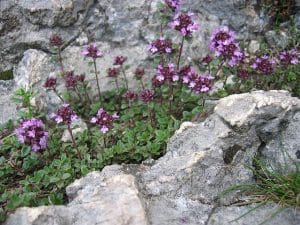
Flowers
The individual flowers are tiny – up to 5mm across – and are purple to pink in colour. They appear in densely packed bunches. It flowers between May and June.
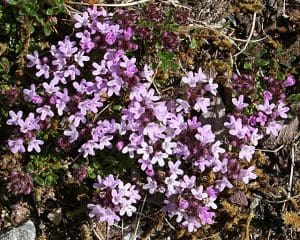
Habitat
It’s a common species and is mostly found on dry grassland, heaths and sand dunes’ but also on cliffs and rocky places.
Known Hazards
None Known
Could be Confused with
Because of the familiar fragrance about the only things it could be confused with are other Thymes such as Thymus vulgaris (which does sometimes appear in the wild) or Large Thyme (Thymus pulegoides) but Wild Thyme grows from runners and the others do not. They are all edible anyway.
Edible Uses
Use as you would bought Thyme, it goes particularly well with chicken and in Italian food.
It’s also great for flavouring oils and vinegars
Notes on Herbal Uses
The distinctive flavour of Thyme comes from the chemical thymol, which has proven anti-bacterial and anti-fungal properties.
Thyme has been used in herbal medicine for centuries to treat many ailments including breathing problems, bronchitis, and swollen airways, kidney and bladder disorders, to improve blood circulation, to lower bad cholesterol, and to treat intestinal gas and colic, improve sleep, to stimulate the immune system, and to treat infections.
Some also apply the plant directly to the skin to kill germs, and to treat arthritis, eczema, wounds, and sprains.
A really simple Wild Thyme infusion or tea is also effective in cases of flatulence, excessive gas and weak digestion. The tea is said to be useful in cases of headaches and nervous disorders.
Extra notes from the Foragers
The origin of the word, Thyme, is from the Greek word, ‘thumos’, which means courage. During Medieval times, Thyme was thought to have been an emblem of bravery.
The word Thyme may also come from the Greek word, ‘thymos’, meaning perfume as it is very fragrant and aromatic.
References:
https://www.first-nature.com/flowers/thymus-polytrichus.php
more about its health properties




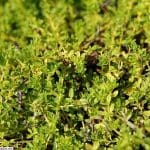
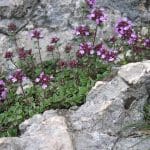
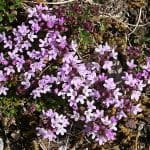



Leave a Reply
You must be logged in to post a comment.